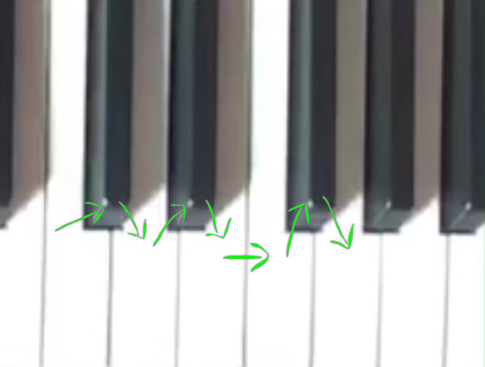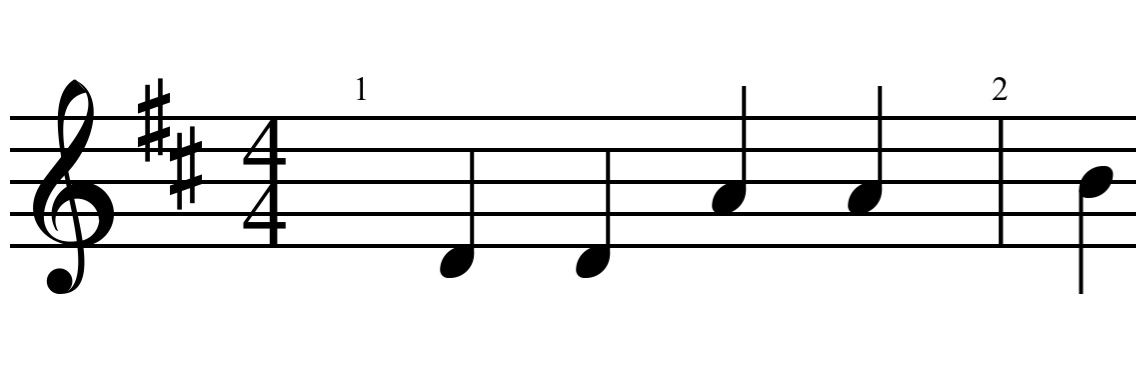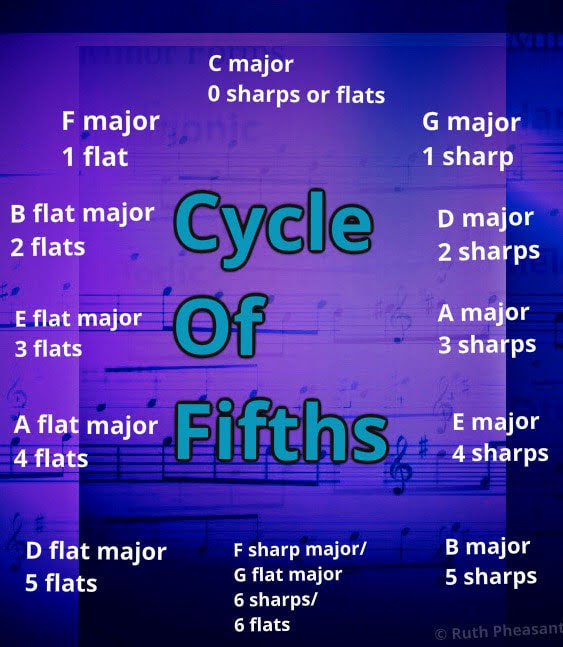Music Theory - The Cycle of Fifths

Here is a method for working out how many sharps and flats each major key has, which sharps and flats they are, and what order the sharps and flats are written in the key signature. The key signature is the group of sharps and flats written at the beginning of every line (or stave) of music, and it shows which notes throughout the score should be sharpened or flattened. Looking at the key signature enables us to work out what key a piece of music is in.
You can also find a video demonstration for two octaves of each major scale below, due to popular demand amongst my piano students. Practising scales can help you become more familiar with each key and key signature. You can find demonstrations and notation including fingering of all harmonic and melodic minor scales here.
You can also find a video demonstration for two octaves of each major scale below, due to popular demand amongst my piano students. Practising scales can help you become more familiar with each key and key signature. You can find demonstrations and notation including fingering of all harmonic and melodic minor scales here.
C Major:
To work out all major key signatures, a starting point will be C major. If a piece of music is in the key of C major it will have no sharps or flats in the key signature. Here is an example:
The extract of music above is in the key of C major. We can see that there are no sharps or flats in the key signature.
C major scale video demonstration
Sharp Key Signatures
To work out key signatures with sharps, follow this method:
G Major:
For the key signature with one sharp (F sharp), go up a *perfect 5th from C and you get G. So G major has a key signature of one sharp, that sharp is F sharp. See the picture below showing an extract of music in G major.
G major scale video demonstration
*An interval of a 5th is a distance of 5 letter names, so C to G is a 5th because you count C,D,E,F,G. There are different kinds of 5ths depending on whether you sharpen or flatten the top or bottom note of the interval. To get a perfect 5th, ensure that the top and bottom notes are 7 semitones apart. In the picture below, each green arrow shows a distance of a semitone. (A semitone is the shortest distance between two pitches or keys on the piano.)
D major:
For the key signature with two sharps, go up a perfect fifth from G and you get D. So D major has two sharps. To work out what those two sharps are: First of all, keep in mind that the first sharp of any sharp key signature is always F sharp. Then when you add more sharps, you always go up a perfect fifth from the previous one. So a perfect 5th above F sharp is C sharp. So a key signature with two sharps has F sharp and C sharp, in that order. See the picture below:
D major scale video
A Major:
For the key signature with three sharps, go up a perfect fifth from D and you get A. So A major has three sharps. The first two sharps are the same as previously: F sharp and C sharp. To work out the third sharp, go up a perfect 5th from C sharp and you get G sharp. So A major has F sharp, C sharp and G sharp in the key signature, in that order. See the picture below:
A major scale
E Major:
For the key signature with four sharps, go up a perfect fifth from A and you get E. So E major has four sharps. The first three sharps are the same as previously: F sharp, C sharp and G sharp. To work out the fourth sharp, go up a perfect 5th from G sharp and you get D sharp. So E major has F sharp, C sharp, G sharp and D sharp in the key signature, in that order. See the picture below:
E major scale
B Major:
The same principles apply for B Major which has five sharps in the key signature. B is a perfect fifth above E, so it has one more sharp in the key signature than E major. That one extra sharp is up a perfect fifth from the last one in the E major key signature which was D sharp. A perfect fifth above D sharp is A sharp. So B major has the sharps F, C, G, D, and A. See the picture below:
B major scale
F sharp major:
The major key with six sharps is F sharp major, because F sharp is a perfect fifth (7 semitones) above B. Those sharps include the same 5 sharps as in B major, plus one extra. To work out this extra one, go up a perfect fifth (7 semitones) from A sharp - you get E sharp. (This is actually a white key on the piano, and the same key as F, but we don’t call it F because we’ve already got F sharp in this key, and in a major scale we don’t have two different notes with the same letter name. So we call it E sharp.) So F sharp major has these sharps in the key signature: F, C, G, D, A and E. See the picture below
F sharp major scale
Flat Key Signatures
To work out key signatures with flats, start again at C, and work out everything from there. This time you need to go down a perfect fifth from each previous key.
F Major:
Going down a perfect fifth from C major will give you F Major which has one flat. That flat is B flat. See the picture below:
F major scale
B Flat Major:
To get the key with two flats in the key signature, go down a perfect fifth from F - you end up with B flat. So B flat major has two flats in the key signature. The first flat in any flat key signature will always be B flat. To work out the next flat go down a perfect 5th (or up a perfect 4th which is 5 semitones and you end up with the same note). This gives you E flat. So B flat major has B flat and E flat in the key signature. See the picture below:
B flat major scale
E Flat Major:
For the key with three flats, go down a perfect fifth from B flat, and you get E flat. To work out the third flat in the key signature go down a perfect 5th from the last flat (E flat) in the last key signature (B flat major) and you get A flat. So E flat major has B flat, E flat and A flat:
E flat major scale
A Flat Major:
The next one is A flat major which has four flats. (A flat is down a perfect fifth from E flat). To get the fourth flat go down a perfect fifth from the last one (A flat) in the previous key signature and you get D flat. So A flat major has 4 flats: B, E, A, D:
A flat major scale
D Flat Major:
The same principle applies to D flat major which has five flats, and those five flats are B, E, A, D and G:
D flat major scale
G Flat Major:
The same principle also applies to G flat major which has six flats: B, E, A, D, G and C. However all the notes in the G flat major scale are *enharmonic equivalents of the notes in an F sharp major scale, so effectively G flat major and F sharp major sound the same, and look the same on the piano. See the picture below.
*Enharmonic equivalent means when a note has more than one name. In other words it is when two or more different note names refer to exactly the same pitch. For example, an F sharp is exactly the same note or key on the piano as a G flat. F sharp and G flat are enharmonic equivalents. Another example would be B flat and A sharp.
*Enharmonic equivalent means when a note has more than one name. In other words it is when two or more different note names refer to exactly the same pitch. For example, an F sharp is exactly the same note or key on the piano as a G flat. F sharp and G flat are enharmonic equivalents. Another example would be B flat and A sharp.
G flat major scale
Note: In order to make key signatures easier to read, the sharps and flats are generally arranged in a zig zag pattern. So you choose the octave in which to write the sharp or flat according to this pattern. For example, for a key signature of four flats (A flat major with B flat, E flat, A flat and D flat), even though you can think of D flat as being a fifth below A flat (in order to work out which note to flatten), in the key signature the flat sign is written on the higher D line of the stave, instead of the lower D space.




























